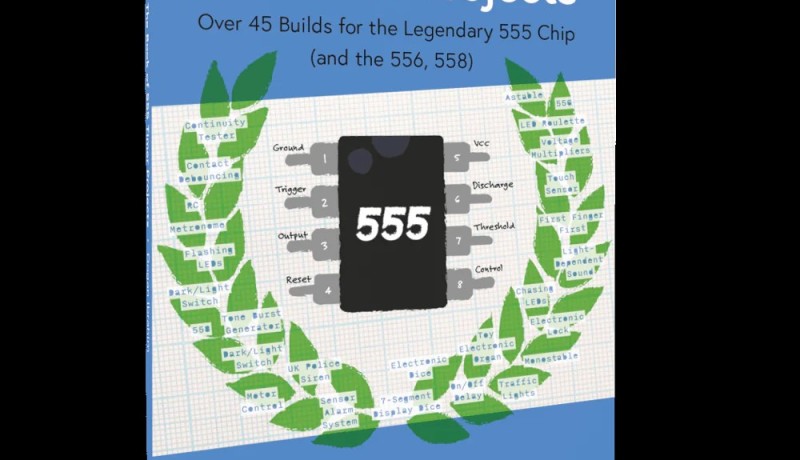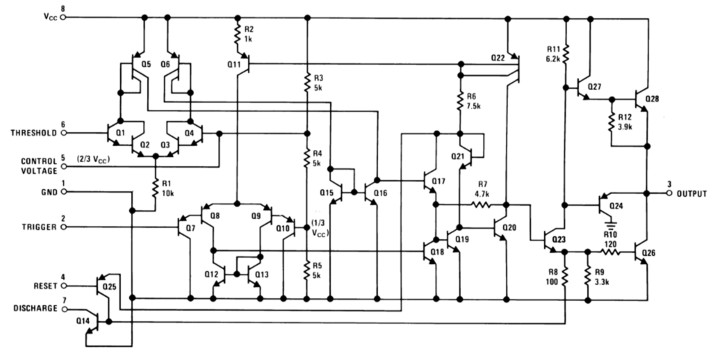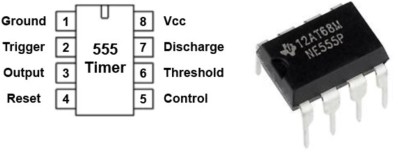Out Now: The Book of 555 Timer Projects
August 08, 2024
on
on

Since it became commercially available, many novel and unique commercial, industrial, and domestic circuits have been developed using the "555" chip, originally designed using bipolar junction transistor technology. It is interesting to note that after about 50 years, the 555 chip is still very popular and used in many applications, although the CMOS versions seem to be more popular in portable low-power applications.
Over the years, derivations of the basic 555 timer chip has been produced. The 556 incorporates two timer circuits, while the 558 provides four of these in one package. In 2017, it was reported that over a billion 555 timer chips were produced annually. As a result of this, it is known as the most popular IC ever produced. The chip has been manufactured by many popular chip manufacturers, such as Intel, Texas Instruments, Signetics, Raytheon, STMicroelectronics, and others.
It was initially thought that the part name “555” came from the fact that there are three 5 kΩ voltage divider resistors used inside the chip. It was however stated by the original manufacturers that the part number 555 was arbitrary and the fact that the chip had three 5 kΩ internal resistors was a coincidence. What do you think? Let us know in the Comments below.
The projects given in the book can be modified or expanded by the readers for their own applications. Electronic engineering students should find the projects useful, especially during the development of their final year projects and in their laboratory work. Additionally, people engaged in designing small electronic circuits and electronic hobbyists should find the projects fun, educational, interesting, and useful.

Historically...
Over the years, derivations of the basic 555 timer chip has been produced. The 556 incorporates two timer circuits, while the 558 provides four of these in one package. In 2017, it was reported that over a billion 555 timer chips were produced annually. As a result of this, it is known as the most popular IC ever produced. The chip has been manufactured by many popular chip manufacturers, such as Intel, Texas Instruments, Signetics, Raytheon, STMicroelectronics, and others.It was initially thought that the part name “555” came from the fact that there are three 5 kΩ voltage divider resistors used inside the chip. It was however stated by the original manufacturers that the part number 555 was arbitrary and the fact that the chip had three 5 kΩ internal resistors was a coincidence. What do you think? Let us know in the Comments below.

The Learn-by-Projects Approach
This book is about the design of 555 timer IC based projects, and over 45 of these are given in the book, all fully tested and documented. All the projects given in the book have been tested fully by the author by constructing them individually on a small breadboard. You are not required to have any programming experiences for constructing or using the projects given in the book. However, it will be useful if some knowledge is available of basic electronics and the use of a breadboard for constructing and testing electronic circuits. The following subheadings are given for each project in the book: Title of the project; Block diagram; Design; Circuit diagram; Fritzing diagram (where possible); Construction details; Testing procedure.The projects given in the book can be modified or expanded by the readers for their own applications. Electronic engineering students should find the projects useful, especially during the development of their final year projects and in their laboratory work. Additionally, people engaged in designing small electronic circuits and electronic hobbyists should find the projects fun, educational, interesting, and useful.
Pssst...
Head over to the Elektor Store page to browse the book contents. For the 555 people on the planet with a love of the 555 but a hate for paper, there's an e-book version as well. It is rumored that a kit of parts will be available shortly to support the 45+ builds described in the book.Read full article
Hide full article




Discussion (1 comment)